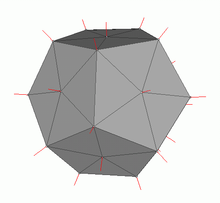Vertex normal

In the geometry of computer graphics, a vertex normal at a vertex of a polyhedron is a directional vector associated with a vertex, intended as a replacement to the true geometric normal of the surface. Commonly, it is computed as the normalized average of the surface normals of the faces that contain that vertex.[1][2] The average can be weighted for example by the area of the face or it can be unweighted.[3][4] Vertex normals can also be computed for polygonal approximations to surfaces such as NURBS, or specified explicitly for artistic purposes. Vertex normals are used in Gouraud shading, Phong shading and other lighting models. Using vertex normals, much smoother shading than flat shading can be achieved; however, without some modifications, it cannot produce a sharp edge.[5]
References
- ↑ Henri Gouraud. "Continuous Shading of Curved Surfaces." IEEE Transactions on Computers, C-20(6) : 623--629 (June 1971).
- ↑ Andrew Glassner, I.6 Building vertex normals from a unstructured polygon list, in Graphics Gems IV, edited by Paul S. Heckbert, Morgan Kaufmann, 1994. pp. 60--74
- ↑ Nelson Max, Weights for Computing Vertex Normals from Facet Normals, Journal of Graphics Tools, Volume 4, Issue 2, 1999 p. 1-6
- ↑ Grit Thürrner and Charles A. Wüthrich, Computing Vertex Normals from Polygonal Facets. Journal of Graphics Tools, Volume 3, Issue 1, 1998. pp. 43-46
- ↑ Max Wagner, Generating Vertex Normals, https://web.archive.org/web/20130531101356/http://www.emeyex.com/site/tuts/VertexNormals.pdf